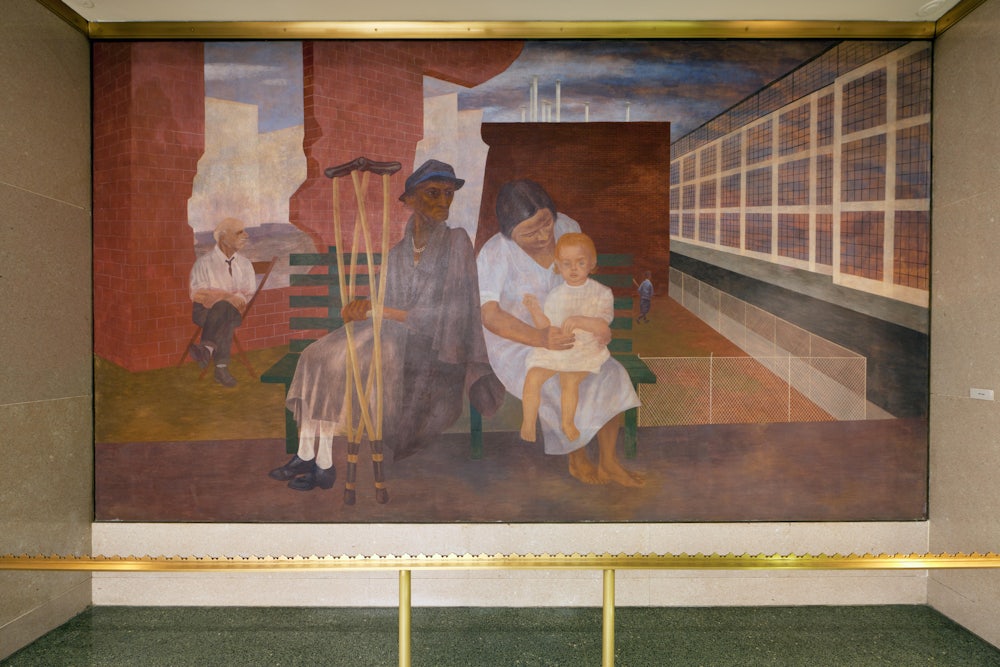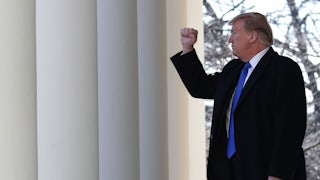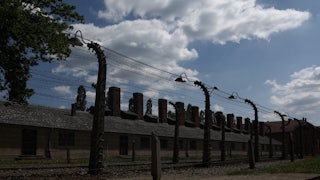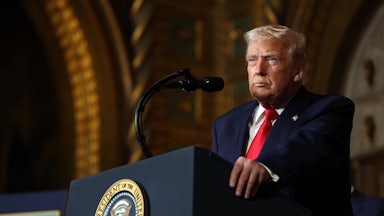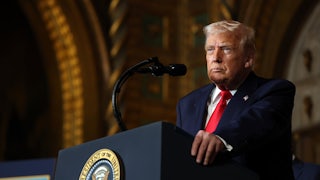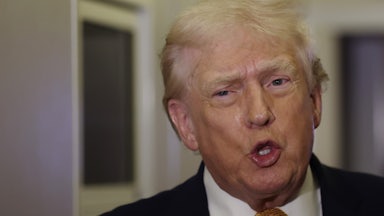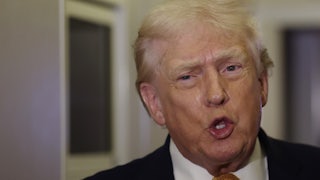Last Friday, the Voice of America’s Washington staff—a skeletal remnant of its workforce because President Donald Trump has fired everybody else or placed them on administrative leave—received a text from H.R. stating that they’ll be relocated “as quickly as possible” out of their present headquarters. The reason is that the General Services Administration, which manages property for the federal government, wants to move fast to sell the Wilbur J. Cohen Federal Building, which, after years of deferred maintenance—a leaky roof, temperamental elevators, and electrical trunk lines dating to the Great Depression—Congress agreed to unload in January.
Trump’s blatantly illegal efforts to shutter the Voice of America, which he calls “The Voice of Radical America,” and which its de facto chief executive, Kari Lake, has called “a rotten piece of fish,” are a gift to truth-suppressing regimes in China and Russia. The vigorous fight in the courts to halt this authoritarian power grab is being covered expertly by The Washington Post and others, and if you haven’t been following that story I urge you to catch up.
Today I want to tell a different story—one that hasn’t been covered by anybody. It’s about that decrepit government building. Before your government sells it off—more than likely at a fire-sale price, because our real estate–genius president is trying, all at once, to sell multiple government buildings into a historically depressed post-Covid commercial market—you should know that it contains probably the most distinguished sample of New Deal–era public art in all of Washington, D.C.—one whose existence is among the capital’s best-kept secrets.
The work in question is a gorgeous series of frescoes by Ben Shahn (1898–1969) celebrating the 1935 establishment of Social Security. “I think the Social Security mural is the best work I’ve done,” Shahn wrote when he completed the work in June 1942. “Anyway, it was the most satisfying. I felt I had everything under control—or almost under control—the big masses of color to make it decorative and the little details to make it interesting.”
Your great-grandparents paid Shahn to paint these frescoes. Now your government is throwing them away.
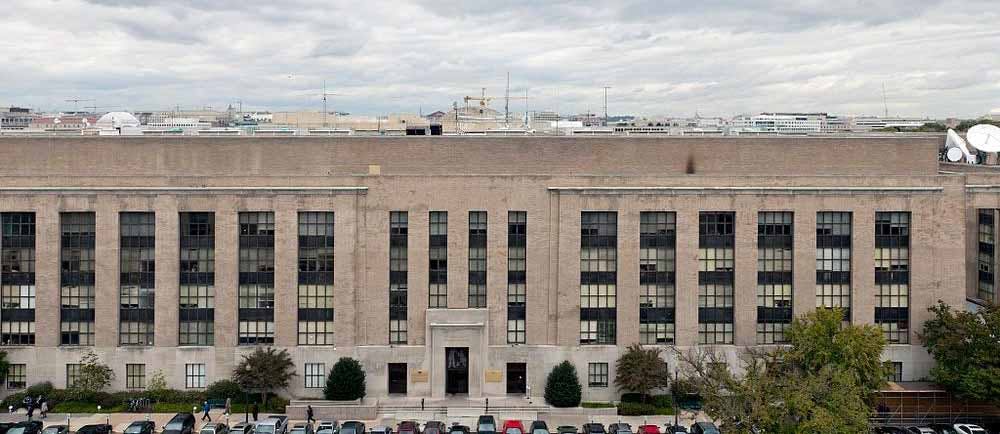
Do you know the social realist painter, illustrator, and photographer Ben Shahn? You’ll find his work on the walls of just about every major museum in America: the Metropolitan Museum of Art, the Art Institute of Chicago, the Getty, the Whitney, the Phillips, Crystal Bridges, the Museum of Modern Art, the National Gallery, and so on. In 1977, Woody Allen used Shahn as a cultural signifier in Annie Hall. Flirting with Carol Kane at a party, Allen says: “You, you, you’re like New York, Jewish, left-wing, liberal, intellectual, Central Park West, Brandeis University, the socialist summer camps and the, the father with the Ben Shahn drawings, right?”
“I love being reduced to a cultural stereotype,” Kane replies.
Shahn’s star started to fade in the late 1950s as social realism became eclipsed by abstract expressionism, and by 1998 the Post art critic Paul Richard dismissed Shahn as “at best a minor painter.” Probably not a lot of people under the age of 50 know who Shahn was. Even in 1977, Allen’s Ben Shahn joke was fast approaching its sell-by date.
But at midcentury, Shahn was, Zachary Fine observed in The New Yorker last June, “one of the most in-demand artists in America.” In 1947, when Shahn was not yet 50, the Museum of Modern Art staged a Shahn retrospective. A 1948 Look magazine poll of museum directors, curators, and art critics placed Shahn fifth among American painters (right below Stuart Davis). In 1954, MOMA selected Shahn as one of two American painters to represent the United States at the Venice Biennale (the other was Willem DeKooning). And in 1956, Shahn became the first artist to deliver Harvard’s prestigious Charles Eliot Norton Lectures. These talks were republished earlier this month by Harvard University Press, with a new introduction by Adam Gopnick that argues Shahn is due for a revival. I agree.
“Such Shahn mural cycles as ‘The Meaning of Social Security’ in Washington, DC,” writes Gopnik, “which might not so long ago have caused more of a mere period smile … than real appreciation, now have a new credibility.” That’s because the circumstances that brought social realism into being a century ago—xenophobia, the threat of fascism, economic inequality—are roaring back. It’s no small irony that the president advancing them is indifferent to (indeed, probably unaware of) the imminent loss of Shahn’s social-realist masterwork.

The occasion for Fine’s New Yorker piece was a Shahn retrospective at the Jewish Museum on the Upper East Side. It was at that exhibit (which runs until October 26) that I got my first inkling of the forgotten Shahn mural inside a building I’d never heard of, built to house Social Security administrators. I feel comfortable calling it forgotten (even though Gopnik obviously remembered it) because three studies for the mural included in the exhibit were accompanied by explanatory text that was a little vague on the question of whether the building was still standing.
Initially, I guessed it was not. In four decades of living in Washington, I’d never once heard anybody mention the Shahn frescoes. Our nation’s capital is not so rich in local culture that even a halfway-curious resident is likely to miss any of its constituent parts. We’ve got go-go music, half-smokes, blue crabs (really more of a Baltimore thing), the Clover Adams gravesite, “Cool” Disco-Dan, Senate Bean Soup (meh), picnics underneath airplanes landing at National Airport (never tried it) … and already you can see I’m groping. Our streets, when they aren’t numbered, are named after grandiose concepts (Independence, Constitution) or after states (Pennsylvania, Georgia, Colorado). My first impression when I arrived 45 years ago (for an internship, as it happens, at The New Republic) was that this city was built by people who wanted to live someplace else.
My point is that before attending that Jewish Museum exhibit, I’d never heard of Shahn’s D.C. frescoes. I knew there was some New Deal public art in Washington, of course, especially in the Interior Department building, but I didn’t know much about it.*
Recent articles in The Washington Post and The New York Times about the threat to public art under the Trump administration, which in other locales includes notable works by Alexander Calder and Ellsworth Kelly, neglect to mention Shahn. The last instance I can find when the Post made even a passing reference to the Shahn mural was in a March 1980 Style piece (headline: “New Deal Art”) by Anne H. Oman.
But yes, the Shahn frescoes are still here, and so centrally located (across Independence Avenue from the National Museum of the American Indian) that I must have passed the building, whose ground floor houses them, a thousand times without noticing it. Also still standing is a separate mural by Philip Guston situated in the building’s auditorium (also on the ground floor), though it’s so well hidden that two former VOA officials told me they had no idea of its existence. Two blocks to the north, the National Gallery of Art hosted a major Guston retrospective in 2023.
“Our collection is your collection,” says the website of the GSA Fine Arts Collection. “These artworks were created by and belong to the American people.” But when I tried to go see the Shahn and Guston murals last week, a security guard told me no dice. “This building is CLOSED,” she said.
The GSA’s art staff used to arrange tours of the Shahn frescoes and other art in federal buildings. But Nick Hartigan, a GSA Fine Arts staffer who’s given frequent talks about the Cohen building artworks, reported on LinkedIn last winter that “our entire team in DC was eliminated.” Last week he filed an update stating that after seven months of “waiting to be fired,” he was called back as part of a nine-member D.C. arts team (pared down from 30). “It boggles my mind,” Hartigan wrote, “that a collection like this is not more well known.” I emailed Hartigan requesting a tour of the Cohen building artworks but didn’t hear back. (I imagine he’s very busy catching up on seven months of emails.)
It isn’t just the Shahn and Guston artworks that make the Cohen building worth preserving. The structure was originally intended to be the headquarters for the Social Security Board (later the Social Security Administration). But by the time Shahn finished his frescoes, the War Production Board needed it; after World War II, the Voice of America moved into a building festooned, inexplicably, with art celebrating the glories of social welfare. The Social Security Board found quarters elsewhere. These days it’s in the Baltimore suburbs.
In addition to the Shahn frescoes (The Meaning of Social Security) and the Guston mural (Reconstruction and the Wellbeing of the Family), the Cohen building bears, on its vaguely Egyptian Revival façade, friezes by Emma Lu Davis and Henry Kreis depicting a man bidding wife and child goodbye as he goes off to work (Family Group), a man crouching in despair while another man rests his hand on his shoulder (Unemployment Compensation), two men planting a tree (The Growth of Social Security), and a husband handing his wife an apple plucked from that tree (The Benefits of Social Security).
Another aspect of the building that merit at least some historic interest is what strikes visitors as a bizarre overabundance of bathrooms (nobody at VOA ever had to wait to go to the john). The restrooms appear two by two—a pair of Gents here, a pair of Ladies there—because the civil service was racially segregated. There’s some value in government employees being reminded daily that our federal infrastructure was hostage to white supremacism until 1948.
It’s also pretty nuts for the federal government to give up such a prime location opposite the Mall and two blocks west of the Capitol. “If I was the government, I wouldn’t sell the property,” Grant Turner, former chief financial officer of Voice of America, told me. “That land is always going to keep going up” in value. But in the current real estate market, and with Trump hurrying to unload a cluster of federal buildings, it will sell for a song.
None of this is taken into account in a May 2025 report by the Public Buildings Reform Board, an independent government agency whose recommendation to proceed with the sale was quickly endorsed by White House Office of Management and Budget director and Project 2025 architect Russell Vought (and seconded in those notices VOA employees received last week). “The sale of the property will generate value and return for the taxpayer through shedding liabilities,” is the board’s penny-wise, pound-foolish conclusion. Nowhere in the report is it mentioned that the building is in the National Register of Historic Places (a designation that, alas, provides zero protection from demolition once the property is in private hands) or that it contains any notable art.
It was during Trump’s first term that the GSA first ordered the Voice of America to vacate its historic headquarters. But Trump isn’t entirely to blame. It was President Joe Biden who, shortly before he left office, signed the bill to actually sell the Cohen Building—which, like the PBRB report, makes no mention of the art contained therein—and it was Congress and civil servants at the General Services Administration, enacting the peculiar power politics of the federal budget process, that let the Cohen Building deteriorate over eight decades until its abandonment and sale became practically a foregone conclusion.
I’ll pick up that story in the next installment. In the meantime, repeat after me: Save the Cohen! Save the Guston mural! Save the friezes! Save the Shahn frescoes! And while we’re at it, let’s save the Voice of America too.
* This article originally stated that Washington, D.C. was not a major center for WPA art during the Great Depression, and misidentified the agency that commissioned the Shahn frescoes.
This is a two-part story. To proceed to part two, click here.
